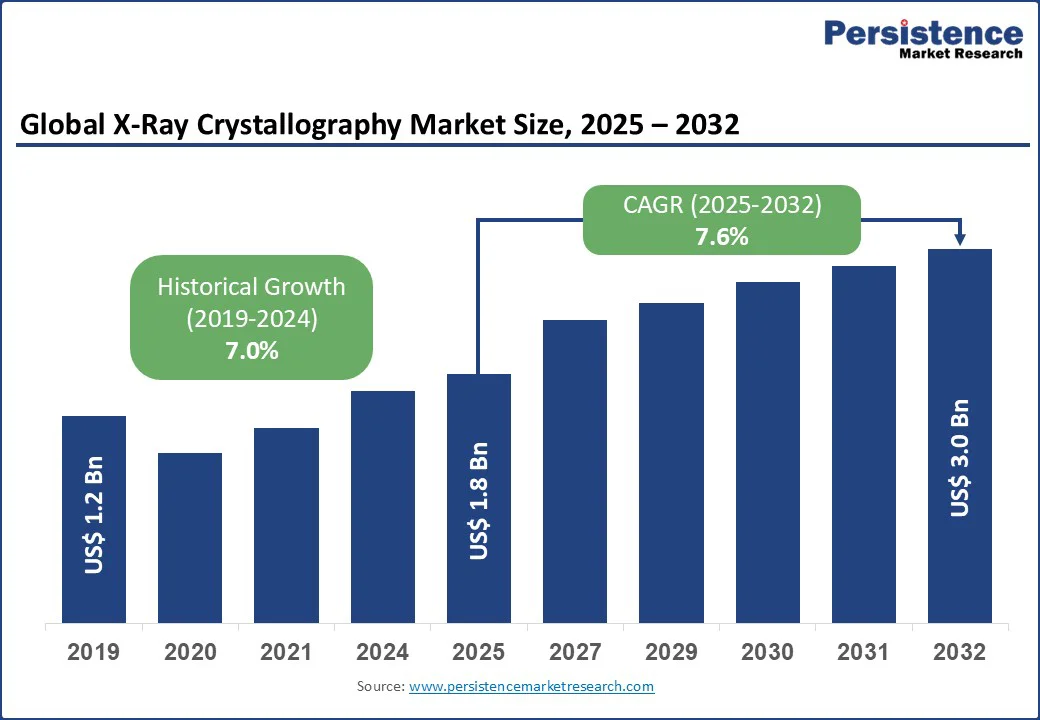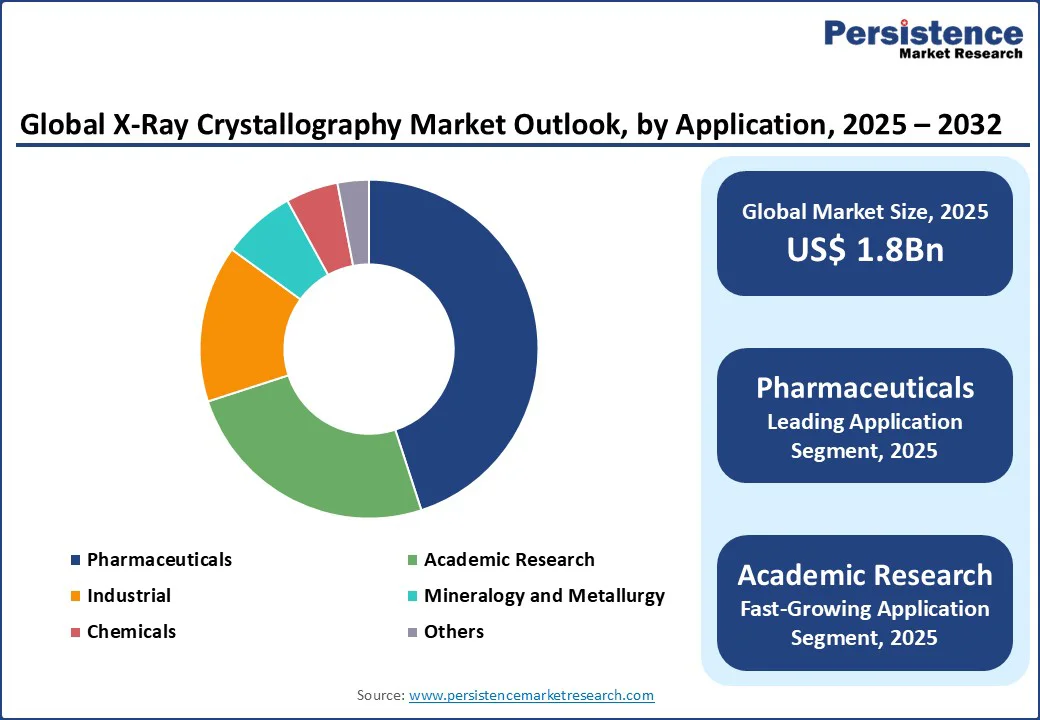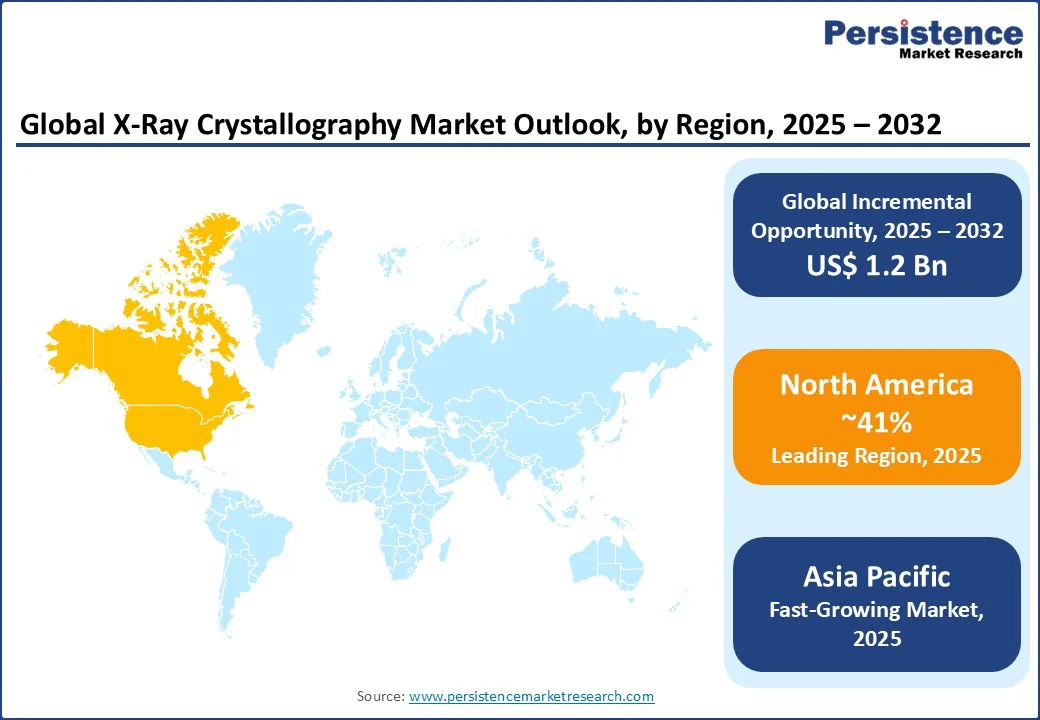ID: PMRREP8818| 181 Pages | 23 Sep 2025 | Format: PDF, Excel, PPT* | Healthcare

The global X-ray crystallography market size is likely to be valued at US$ 1.8 Bn in 2025 and is expected to reach US$ 3.0 Bn by 2032, growing at a CAGR of 7.6% during the forecast period from 2025 to 2032.
The market is experiencing robust growth driven by increasing demand for precise molecular and structural analysis across the pharmaceutical, biotechnology, and materials science sectors. Advancements in high-resolution imaging, automation, and data processing technologies are further propelling the adoption of X-ray crystallography systems.
Key Industry Highlights:

| Key Insights | Details |
|---|---|
|
X-Ray Crystallography Market Size (2025E) |
US$1.8 Bn |
|
Market Value Forecast (2032F) |
US$3.0 Bn |
|
Projected Growth (CAGR 2025 to 2032) |
7.6% |
|
Historical Market Growth (CAGR 2019 to 2024) |
7.0% |
The X-ray crystallography market growth is strongly driven by the increasing demand for drug discovery and development worldwide. As chronic diseases, infectious disorders, and emerging health challenges continue to rise, pharmaceutical and biotechnology companies are intensifying their R&D efforts to create more effective and targeted therapies. X-Ray Crystallography plays a pivotal role in this process by enabling scientists to determine the precise 3D structures of biomolecules, such as proteins, enzymes, and nucleic acids, at atomic resolution. This structural insight is critical for understanding disease mechanisms and for designing drugs that can effectively interact with specific biological targets.
The pharmaceutical industry relies heavily on crystallography to accelerate structure-based drug design, allowing researchers to identify active binding sites and optimize lead compounds with greater precision. This reduces the time, cost, and risk associated with drug development, making it a valuable tool in competitive drug pipelines.
Moreover, collaborations between pharmaceutical companies and academic institutions are expanding, further fueling demand for these partnerships. With the growing focus on precision medicine and biologics, X-ray crystallography is becoming increasingly indispensable, positioning the technology as a key enabler in the global drug discovery and development landscape. For instance, X-ray crystallography played a crucial role during the COVID-19 pandemic in determining the structure of SARS-CoV-2 proteins, facilitating the rapid development of antiviral drugs and vaccines.
The high costs associated with X-ray crystallography instruments and their maintenance pose a significant restraint on market growth. Advanced crystallography systems, such as X-ray diffractometers and high-resolution detectors, require huge capital investment. These costs pose significant challenges, particularly for small and medium-sized research labs, academic institutions, and companies in developing regions with limited financial resources. In addition to the initial purchase, ongoing expenses such as regular calibration, replacement of X-ray tubes, and specialized consumables contribute to the financial burden.
Maintenance of these sophisticated instruments requires skilled technicians and adherence to strict operational standards to ensure accuracy and safety. Downtime due to technical issues or delays in servicing can further hinder research activities and drug discovery pipelines, creating inefficiencies. Moreover, integrating crystallography instruments with supporting technologies, such as AI-enabled analysis software or automated sample preparation systems, adds to overall costs.
For instance, pharmaceutical companies and large research centers can absorb these expenses, but smaller players often struggle to justify the return on investment. As a result, the high cost of instruments and their upkeep acts as a significant barrier to broader adoption, especially in resource-constrained environments.
The X-ray crystallography market presents significant opportunities through advancements in automation and the integration of artificial intelligence (AI). Traditional crystallographic workflows, including sample preparation, data collection, and analysis, are often time-consuming and labor-intensive. However, the incorporation of automated systems and AI-driven tools is transforming these processes, enabling faster, more accurate, and scalable structural analysis. Automation reduces manual errors, improves reproducibility, and enables laboratories to handle larger volumes of samples, which is particularly crucial in pharmaceutical research and high-throughput drug screening.
AI integration further enhances the value of crystallography by enabling advanced pattern recognition, predictive modeling, and real-time data interpretation. Machine learning algorithms can quickly identify molecular structures and predict binding interactions, accelerating structure-based drug design. This not only shortens development timelines but also reduces costs associated with trial-and-error experimentation.
For instance, leading companies such as Bruker and Rigaku are incorporating AI-powered software platforms into their crystallography solutions to deliver automated workflows and improved decision-making for researchers. As the demand for precision medicine, biologics, and advanced materials grows, the combination of automation and AI offers vast opportunities for market expansion. These innovations position crystallography as a smarter, more efficient, and indispensable tool in modern research and industry.
Instruments dominate and account for approximately 55% share in 2025. Their dominance stems from their critical role in providing high-precision structural analysis for applications in pharmaceuticals, biotechnology, and materials science. Advanced instruments, such as those offered by Rigaku Corporation and Bruker Corporation, enable real-time data collection and seamless integration with automated workflows, making them a preferred choice for research institutions and industrial labs. Their modular designs and compatibility with AI-driven software further enhance their appeal, driving adoption among both large enterprises and smaller research entities.
The services segment is the fastest-growing, driven by the increasing outsourcing of crystallographic analysis to contract research organizations (CROs) and specialized service providers. Services, including crystal structure determination and data analysis, are gaining traction due to their cost-effectiveness and ability to support organizations lacking in-house expertise or advanced equipment. The growing complexity of crystallographic studies, particularly in drug discovery, is fueling demand for specialized services, with providers such as Malvern Panalytical and Dectris Ltd. expanding their offerings to meet market needs.
Pharmaceuticals lead the X-ray crystallography market, holding a 45% share in 2025. The segment’s dominance is driven by the critical role of X-ray crystallography in drug discovery, particularly in understanding protein-ligand interactions and designing targeted therapeutics. The rise in biologics development and the need for high-resolution structural data to support drug approval processes are key factors driving growth. Companies like Agilent Technologies and Thermo Fisher Scientific provide tailored solutions for pharmaceutical applications, ensuring high accuracy and efficiency.
The academic research segment is the fastest-growing, fueled by increasing government and institutional funding for structural biology and materials science research. The rise in interdisciplinary studies, such as those combining crystallography with genomics and proteomics, is driving demand for advanced instruments and services. The Asia Pacific region, with its expanding research infrastructure, is a key contributor to this segment’s rapid growth.
Pharmaceuticals hold the largest share, accounting for approximately 49% of revenue in 2025. This end-use segment benefits from the close collaboration between equipment vendors, such as PerkinElmer Inc., and pharmaceutical companies, which offers tailored crystallographic solutions for drug discovery and development. The need for precise structural analysis in complex drug development programs drives the adoption of advanced instruments and services.
The life sciences and biotechnology end-use is the fastest-growing, driven by the increasing application of X-ray crystallography in protein engineering, enzyme studies, and biomolecular research. The rise of personalized medicine and biopharmaceuticals is accelerating demand for crystallographic solutions in this segment. North America and Europe are key regions driving growth, supported by robust research ecosystems and government funding.

North America holds a commanding 41% share of the global X-Ray crystallography market. This dominance is primarily attributed to the region’s highly advanced research infrastructure, strong pharmaceutical and biotechnology industries, and continuous government and private sector investments in life sciences. Countries such as the United States and Canada are home to world-class academic institutions, research laboratories, and healthcare facilities that rely heavily on crystallography for structural biology, drug discovery, and the development of advanced materials.
The presence of leading market players such as Bruker Corporation, Thermo Fisher Scientific, and Agilent Technologies further strengthens the region’s position, as these companies consistently introduce innovative instruments, AI-integrated solutions, and automated platforms to meet the growing demand. Moreover, North America benefits from a well-established regulatory framework that encourages R&D in drug discovery and precision medicine, where X-ray crystallography plays a pivotal role in identifying molecular targets and accelerating drug design.
The increasing prevalence of chronic diseases, coupled with rising investments in biologics and personalized medicine, also drives the adoption of these therapies. With strong collaborations between academia, industry, and government agencies, North America is expected to remain at the forefront of crystallography innovation and market growth.
Europe is a significant player in the X-ray crystallography market, supported by strong institutional frameworks and collaborative research programs. Leading countries, including Germany, the United Kingdom, and France, drive market growth through extensive investments in scientific research and biotechnology. The European Molecular Biology Laboratory (EMBL) and national agencies, such as the UK’s Medical Research Council (MRC), are driving demand for advanced crystallographic systems in structural biology and materials science.
Companies like Malvern Panalytical and Oxford Instruments plc are at the forefront of developing cutting-edge instruments and services, catering to both academic and industrial end-users. Europe’s focus on sustainable innovation and interdisciplinary research, such as the integration of crystallography with AI-driven data analysis, is driving market expansion. The region’s emphasis on advancing drug discovery and materials characterization, supported by programs such as Horizon Europe, is expected to ensure steady growth in the coming years.
The Asia Pacific region emerges as the fastest-growing market in X-Ray Crystallography, driven by increasing government funding for research, the rapid expansion of the biotechnology and pharmaceutical sectors, and rising demand for advanced analytical tools. Countries such as China, India, and Japan are at the forefront of this growth, driven by heavy investments in healthcare infrastructure, R&D facilities, and academic research programs. Governments across the region are actively supporting initiatives in structural biology and precision medicine, recognizing the importance of crystallography in drug discovery, disease research, and material sciences.
China, for instance, is investing significantly in state-of-the-art crystallography centers to support its booming pharmaceutical industry, while India’s expanding biotech ecosystem is adopting crystallographic tools for both academic and industrial applications. Additionally, increasing collaborations between regional universities and global players, such as Rigaku, Bruker, and JEOL Ltd., are enhancing technology adoption and accessibility. The region’s large patient base and growing focus on chronic diseases also fuel demand for structure-based drug discovery solutions. Collectively, these factors position the Asia Pacific not only as the fastest-growing market but also as a critical hub for future innovation and global collaborations in crystallography.

The global X-Ray Crystallography market is highly competitive, with a mix of global leaders and specialized players. In North America and Europe, companies such as Rigaku Corporation, Bruker Corporation, and Thermo Fisher Scientific lead the sector through advanced R&D, strategic collaborations, and strong product portfolios. In the Asia Pacific, rapid growth in research infrastructure and pharmaceutical demand is attracting investments from global and regional players, such as JEOL Ltd. and Anton Paar GmbH. Innovations in AI-integrated and automated crystallographic systems, high-performance detectors, and advanced data-analysis tools drive competition.
Leading companies are pursuing partnerships with academic and pharmaceutical institutions, making acquisitions to expand their portfolios, and adopting digital-first approaches for marketing and supply chain efficiency. While global giants dominate advanced crystallography solutions, niche and regional players continue to serve cost-sensitive and specialized applications, creating a dynamic and fragmented market landscape.
The global X-ray crystallography market is projected to reach US$ 1.8 Bn in 2025.
The increasing demand for drug discovery and development is a key driver.
The X-ray crystallography market is poised to witness a CAGR of 7.6% from 2025 to 2032.
Advancements in automation and AI-integrated crystallographic technologies are a key opportunity.
Rigaku Corporation, Bruker Corporation, Thermo Fisher Scientific, Agilent Technologies, and PerkinElmer Inc. are key players.
| Report Attribute | Details |
|---|---|
|
Historical Data/Actuals |
2019 - 2024 |
|
Forecast Period |
2025 - 2032 |
|
Market Analysis |
Value: US$ Bn, Volume: As Applicable |
|
Geographical Coverage |
|
|
Segmental Coverage |
|
|
Competitive Analysis |
|
|
Report Highlights |
|
By Product Type
By Application
By End-Use
By Region
Delivery Timelines
For more information on this report and its delivery timelines please get in touch with our sales team.
About Author